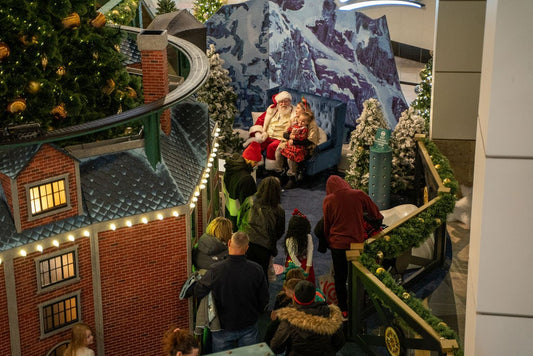Maria Morabito’s Plurality of Voices reads like a line of music. Its red felt shapes, cut on curves and hung from invisible lines, descend from left to right across a store window on Orange Street with a pop toward the end, like a high note or a visual clap on a sound meter. Gravity does the work of shaping the pieces further, pulling them into elegant forms. There’s a plurality of shapes, of “voices,” sometimes twisting in the faintest movement of air, but ultimately, they are more alike—in color, texture, size, form—than different. They are a unity.
sponsored by
Morabito’s mesmerizing work is just one of 20 installations mounted in the downtown windows of unoccupied buildings as part of a Town Green District project called Windowed Worlds. Launched last year, Windowed Worlds accidentally anticipated our need for visual art at a time when most galleries and museums are still closed. Four more displays will be mounted soon.
A walk along the south side of the Green reveals several side-by-side installations, including a collection of Mail Art, part of a 50-year-old populist movement in which artists mail their art to one another in order to share “their creative world vision without considering their work as products with market value,” a sign in the window explains. Local artist Molly Gambardella put out the call for this exhibit and received more than 200 pieces from “over eight participating countries.” The resulting collection of business-sized envelopes forms a grid of ink drawings, collages, watercolors and other media. One window envelope is sewn from shimmery gauze checked with pink thread. Another is a colorful piece of what appears to be wool, studded with mirrored beads. The envelopes bear images of an anatomical heart, a Venus flytrap, a dragon, geometric shapes and random lettering. All of them were public art before they were even officially displayed, since they were already on view as they traveled through the US mail.
Around the corner on Church Street are four more window offerings, including a group of paintings by faculty and students of the Educational Center for the Arts. A portrait by Fetty Brockenberry, tipped sideways, spills to the bottom of its frame. Black highlights of eye and mouth slip and lose their shape, as if the subject’s form won’t hold. Ruby Gonzalez Hernandez’s portraits are linked on a field of green geometry like the squares of a city map. The strokes of each brown face swoop into the next, linking them as if to emphasize their community.
In another window nearby, Audrey Knight’s Light Cycle plays with both light and cycle. Large circular forms like giant gears are cut with geometric, often Gothic, shapes evoking stained glass church windows. The midday sun throws their gold patterns on a white backdrop, sometimes focused, sometimes blurred. As the sun cycles across the sky, so the light cycles along the backdrop.
In fact, light is a common element in these windows, helping to brighten the city’s streets even after dark. A collection of Laser-Cut Lamps made at the main library’s Ives Squared Tinker Lab emits a coppery glow. A god and goddess hold orbs—sun and moon, perhaps—as they float above a whimsical paper-cut seascape full of wild creatures, castles and a pine-covered mountain in Flux, a piece by Paier College of Art students and instructors. A large, ivory-colored seed scored with labial lines lights up in the center of a “chorus” of delicate petals folded like vaginas in Mengxi “Althea” Rao’s Chorus.
Along a route across Chapel, down Church and across Crown to Orange, walkers will also pass Artspace, where the exhibition The View from Here remains up through June 15. The show is intended as an answer to the coronavirus question, “In this moment, what does the view from here look like for you?” As the Artspace website points out, The View From Here includes all the “imperfect fits, extreme partial viewings and DIY fixes” attendant to a show mounted at a moment of crisis in a gallery turned inside out.
One of the best things about the works of art in Windowed Worlds is that most of them lack any explanation beyond a title, making them accessible to everyone’s imagination. The project brings art to those who might not normally visit a gallery and makes a “visual dialogue” possible between artists and a new audience, says Elizabeth Bickley, manager of public space planning and development for Town Green District. It also creates an interesting design challenge for artists to create a piece that works in an “unwieldy” three-dimensional space. Bickley says Windowed Worlds encourages property owners to think more about the public faces of their buildings. “The goal is that when someone walks a block, they experience life,” she says.
Installations remain for one year or until a new tenant rents a space; applications from artists are accepted on a rolling basis and reviewed by a community jury. The district hopes to help scale up the project for other New Haven neighborhoods as new proposals continue to arrive, offering “a platform to raise up voices and imaginations” that may not have been tapped before, Bickley says.
In that way, what has stood empty is filled and has the chance to fill others.
Photo Key:
1, 2. Connections with Strangers by Mackenzie Pikaart.
3. A Little Slice of Heaven by Amira Brown.
4. Laser-Cut Lamps (detail).
5. Chorus (detail) by Mengxi “Althea” Rao.
6. Flux by Paier College of Art students and instructors.
7. Plurality of Voices by Maria Morabito.
Windowed Worlds
Along Chapel Street, Church Street, Crown Street and Orange Street in downtown New Haven
www.downtownnewhaven.com/windowed-worlds
Written by Kathy Leonard Czepiel. Images 1, 4 and 7 photographed by Kathy Leonard Czepiel. Images 2 and 5 photographed by Dan Mims. Images 3 and 6, photographed by Chris Randall and Elizabeth Bickley, respectively, provided courtesy of Town Green District.








